|
|||||||||||||||||||||||||||||||||||||||||||||||||||||||||||||||||||||||||||||||||||||||||||||||||||||||||||||||
SOLAR WEATHER
and some interesting space stuff
2010
compiled by Dee Finney
JUNE - 2010
PAGE 6
updated - 6-30-10
THIS COMPILATION IS BEING DONE IN HONOR OF KENT STEADMAN
OF www.cyberspaceorbit.com
who left his earthly abode in 2008
2009 SOLAR WEATHER
JANUARY -
FEBRUARY -
MARCH -
APRIL -
MAY -
JUNE -
JULY -
AUGUST -
SEPTEMBER -
OCTOBER -
NOVEMBER
-
DECEMBER
2010 SOLAR WEATHER
JANUARY -
FEBRUARY -
MARCH -
APRIL -
MAY - JUNE - JULY
AUGUST - SEPTEMBER - OCTOBER - NOVEMBER - DECEMBER
On January 17, there were 1092 potentially hazardous
asteroids.
On February 17, there were 1100 potentially hazardous asteroids.
NOTE: These are not 'new' asteroids' merely newly discovered by
people and their new telescopes.
On March 24, there were 1110 potentially hazardous asteroids.
On April 5, there are 1110 potentially hazardous asteroids.
On April 14, there are 1117 potentially hazardous asteroids.
On May 15, there are 1127 potentionally hazardous
asteroids.
On June 19, there are 1133 potentially hazardous asteroids.
On June 23, there are 1138 potentially hazardous asteroids.
|
|
|
||||||||||||||||||||||||||||||||||||||||||||||||||||||||||||||||||||||||||||||||||||||||||||||||||||||||||||||||
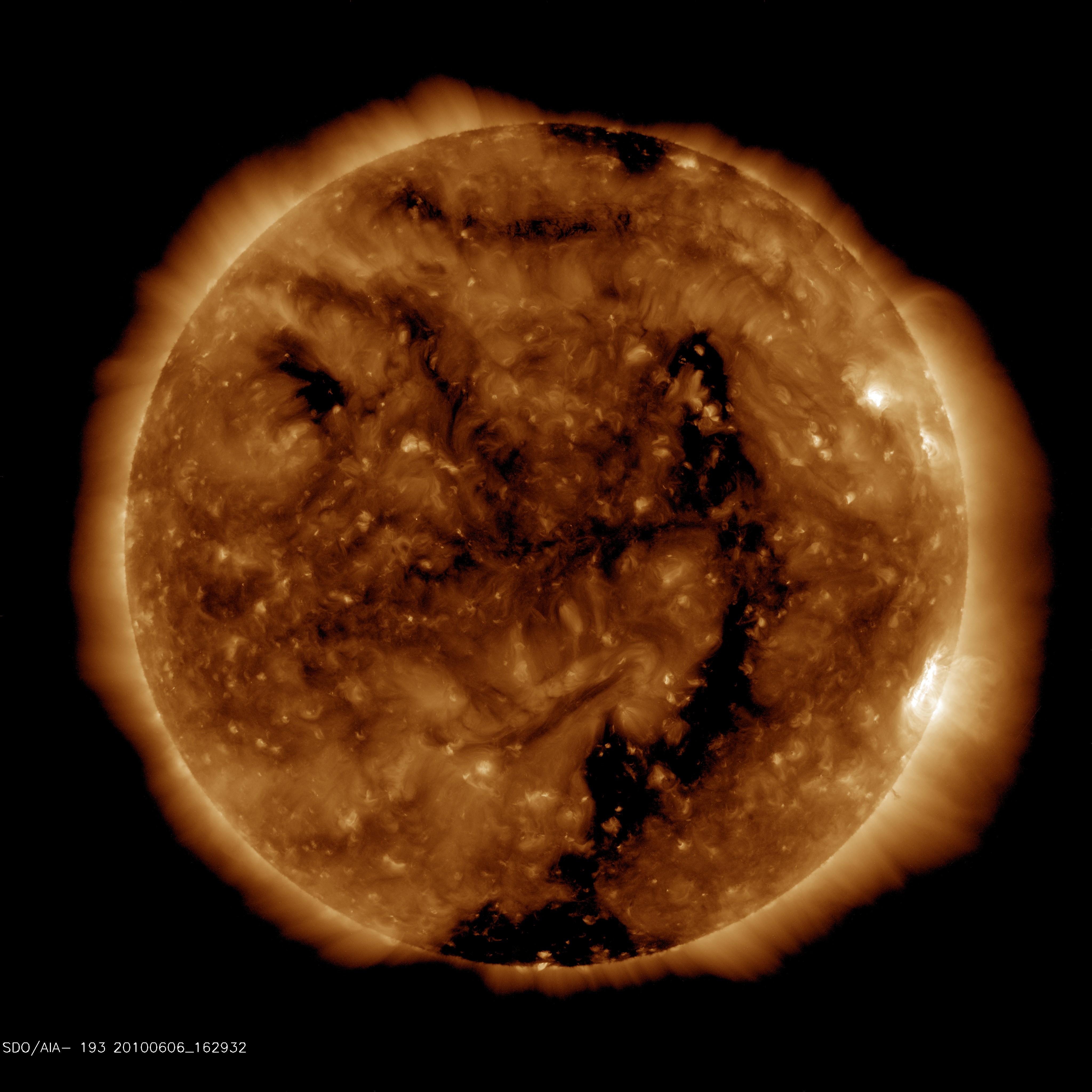
A GOOD LOOK AT A CORONAL HOLE - ONE OF THE LARGEST EVER SEEN
6-5-10
6-30-10 - sunspot 1084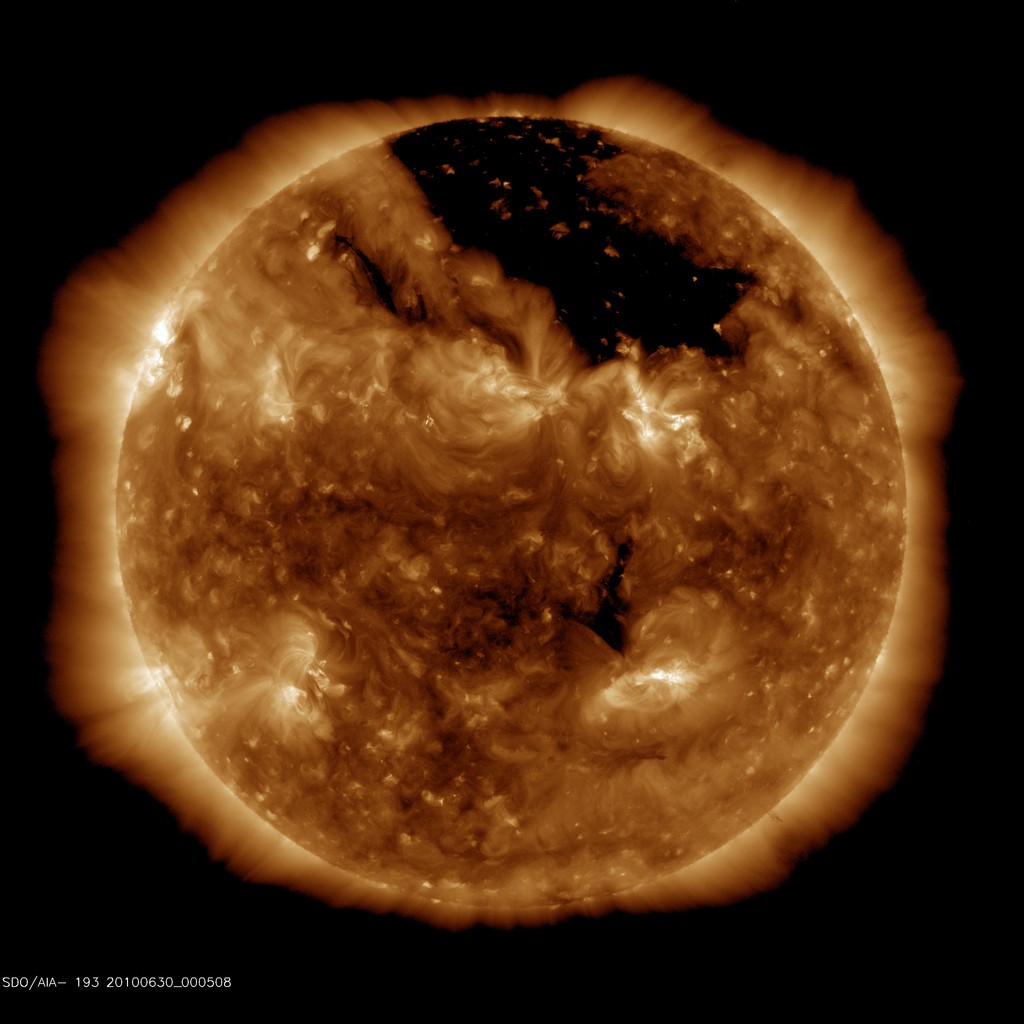 COMPARE THIS CORONAL HOLE TO THE ONE ABOVE. THIS SOLAR WIND SPEED IS THE HIGHEST I'VE EVER SEEN. Current conditions speed: 655.8 km/sec density: 1.4 protons/cm3 explanation | more data Updated: Today at 1314 UT 6-hr max: A5 1300 UT Jun30 24-hr: A5 0140 UT Jun30 explanation | more data Updated: Today at: 1315 UT |
||||||||
| 6-29-30 sunspot 1084 PLASMA PUFFS: A magnetic filament is snaking over the sun's northeastern limb, and it is filled with cool dark "puffs" of solar plasma. Pete Lawrence sends this picture from his backyard observatory in Selsey, UK:
Each puff is about the size of Earth, but much less
dense; solar plasma consists mainly of gaseous hydrogen. If you could
fit one in our atmosphere, it would float. Despite the diaphanous nature of these plasma clouds, they can cause quite a stir if they fall to the stellar surface, producing an intense flash of radiation called a "Hyder flare." So far, however, the puffs seem to be held firmly aloft by the magnetic filament shown in this SDO image. No explosions are in the offing. Current conditions
speed: 590.7 km/sec density: 5.1 protons/cm3 explanation | more data Updated: Today at 2344 UT
6-hr max: A5 2140 UT Jun29 24-hr: B1 1550 UT Jun29 explanation | more data Updated: Today at: 2340 UT
|
||||||||
| 6-28-10 sunspot 1084 Current conditions
speed: 545.1 km/sec density: 2.7 protons/cm3 explanation | more data Updated: Today at 2345 UT
6-hr max: A7 1855 UT Jun28 24-hr: A7 1855 UT Jun28 explanation | more data Updated: Today at: 2340 UT
|
||||||||
| 6-27-10 sunspot 1084 - don't know what
happened to 1083 1084 is exhibiting B-class solar flares NEW SUNSPOT 1084: A new sunspot is rotating into view around the sun's southeastern limb. Rogerio Marcon sends this picture from his backyard observatory in Campinas, Brazil:
The sunspot's dark core is about the size of Earth, and it sits at the vertex of a massive swirl of hot gas. Extreme UV images from NASA's Solar Dynamiics Observatory reveal the million-degree whirlpool: click here. So far the sunspot has been relatively quiet, producing no flares of note, but this could change if the magnetic field becomes unstable. Readers with solar telescopes are encouraged to monitor developments. more images: from John C McConnell of Maghaberry, Northern Ireland; from Howard Eskildsen of Ocala, Florida; from Peter Desypris of Island of Syros Greece; from Jan Timmermans of Valkenswaard, The Netherlands; from Britta Suhre of Rosenheim, Bavaria, Germany Current conditions speed: 521.5 km/sec density: 1.8 protons/cm3 explanation | more data Updated: Today at 2345 UT 6-hr max: A5 1815 UT Jun27 24-hr: B1 0320 UT Jun27 explanation | more data Updated: Today at: 2340 UT FALCON 9 REENTRY: According to US Strategic Command, SpaceX's Falcon 9 rocket reentered Earth's atmosphere on June 27th at 50 minutes past midnight UT (+/- 2 hours). Nominally, this puts the fireball somewhere over the Iraq-Syria border, although the 2 hour uncertainty means reentry could have happened almost anywhere along the rocket's ground track. The Falcon 9 and its companion the Dragon are of interest because they could become commercial successors to NASA's retiring space shuttle. This reentry was the expected conclusion to the Falcon 9's inaugural test flight. |
||||||||
| 6-26-10 - no sunspots Current conditions speed: 452.3 km/sec density: 6.8 protons/cm3 explanation | more data Updated: Today at 2341 UT 6-hr max: A6 1815 UT Jun26 24-hr: A8 0245 UT Jun26 explanation | more data Updated: Today at: 2340 UT LUNAR ECLIPSE: This morning, the Moon passed through the shadow of Earth, producing a partial lunar eclipse. Jared Aicher of Boise, Idaho, photographed the eclipse at maximum, when 54% of the Moon's diameter was covered:
"The lunar eclipse was beautiful as it set over the distant Owyhee Mountains on Saturday morning!" says Aicher. "The light was changing rapidly, and show was magnificent." Note that in Aicher's picture, the eclipse is not the red half of the Moon. That's normal 'moonset reddening' caused by scattering of moonlight in Earth's atmosphere. The eclipse is the dark half of the Moon. That's Earth's shadow cutting the full moon in two. NEW:
Lunar Eclipse Photo Gallery FALCON 9 DECAY: SpaceX's Falcon 9 rocket, launched on June 4th from Cape Canaveral as a possible successor to the space shuttle, is about to reenter Earth's atmosphere. According to US Strategic Command, reentry should occur on June 27th at 0146 UT +/- 7 hours. Nominallly, the rentry should occur over the South Pacific Ocean, but the large uncertainty in decay time makes it impossible to say for sure. Possible sighting opportunities may be found here and here. |
||||||||
| 6-25-10 sunspot 1082 Current conditions speed: 352.8 km/sec density: 16.6 protons/cm3 explanation | more data Updated: Today at 2346 UT 6-hr max: B1 2315 UT Jun25 24-hr: B2 1020 UT Jun25 explanation | more data Updated: Today at: 2340 UT 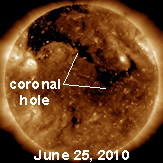 A solar wind stream flowing from the indicated coronal hole could reach Earth as early as June 26th. Credit: SDO/AIA |
||||||||
| 6-24-10 - sunspot 1082 Current conditions
speed: 300.5 km/sec density: 3.4 protons/cm3 explanation | more data Updated: Today at 0246 UT
6-hr max: A7 1800 UT Jun23 24-hr: B1 1100 UT Jun23 explanation | more data Updated: Today at: 2355 UT
AURORAS FROM ABOVE: Have you ever wondered what auroras look like from above? Astronauts onboard the International Space Station found out on May 29th when they flew through a geomagnetic storm and witnessed this green ribbon snaking over the Indian Ocean 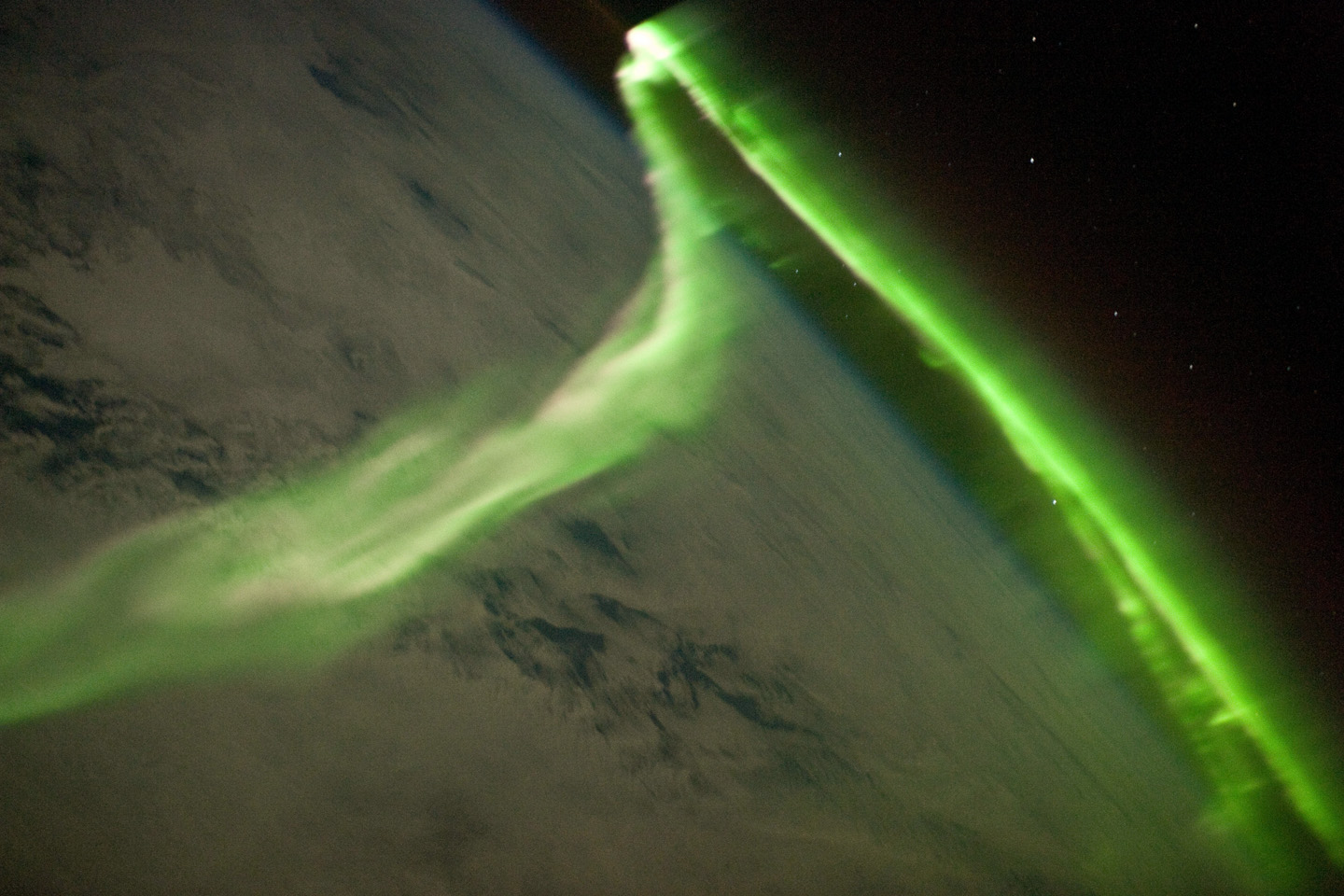 The bright display of Southern Lights was sparked by a solar coronal mass ejection (CME), which hit Earth's magnetic field and sparked a G1-class geomagnetic storm. On the other end of the planet, the same storm produced bright Northern Lights over Wisconsin, Minnesota and parts of Canada. Both poles were ringed in light at the same time. This isn't the first time astronauts have seen auroras underfoot. The shuttle has flown right through auroral curtains with no ill effects--other than time lost while the crew crowds around the window to stare.The ISS also turns out to be a wonderful platform for aurora watching. Next up: A solar wind stream is due to hit Earth's magnetic field on June 26th, possibly sparking a new round of geomagnetic activity. Sky watchers above and below should be alert for auroras. |
||||||||
| 6-23-10 sunspot 1082 - heading for the edge of the
sun. It poses no threat for strong solar flares Current conditions speed: 319.2 km/sec density: 2.5 protons/cm3 explanation | more data Updated: Today at 0805 UT 6-hr max: A7 0630 UT Jun23 24-hr: A7 0630 UT Jun23 explanation | more data Updated: Today at: 0805 UT PARTIAL LUNAR ECLIPSE: This Saturday, June 26th, the Moon will pass through Earth's shadow for a partial lunar eclipse. The event lasts for almost three hours centered on 11:38 UT (4:38 am PDT). At maximum, about 53% of the Moon's surface will be covered by the dark-red core of Earth's shadow. Sky watchers in the Americas, Australia, east Asia and India are favored: visibility map.
DAWN COMET: Comet McNaught (C/2009 R1) is swinging around the sun, and solar glare is making the wispy-tailed comet difficult to see. Nevertheless, astronomer Enrico Colzani was able to glimpse it this morning just before sunrise at the Sormano Astronomical Observatory in Italy:
"The comet was actually moving among the trees, hanging very low over the northeastern horizon at the time I photographed it," he says. "I used a 150mm (4.4-inch) refractor to take this 150 second exposure." Theoretically, the comet could brighten to naked eye visibility around July 2nd when it makes its closest approch to the sun (perihelion). Practically, the bright sun itself will prevent any sightings. After perihelion, the comet will recede from the sun and begin to fade. The final mornings of June, therefore, could offer our last good look at this blue-green apparition from the outer solar system. More information and a sky map are available from Sky and Telescope. See also: ephemeris, 3D orbit.
|
||||||||
| 6-22-10 sunspot 1082 Current conditions speed: 328.2 km/sec density: 3.7 protons/cm3 explanation | more data Updated: Today at 2346 UT 6-hr max: A5 2300 UT Jun22 24-hr: B1 0935 UT Jun22 explanation | more data Updated: Today at: 2340 UT |
||||||||
| 6-21-10 - sunspot 1082 Current conditions speed: 347.9 km/sec density: 0.3 protons/cm3 explanation | more data Updated: Today at 2344 UT 6-hr max: B1 1910 UT Jun21 24-hr: B1 1910 UT Jun21 explanation | more data Updated: Today at: 2340 UT 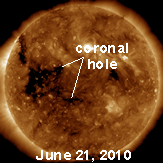 Today isi the summer solstice. 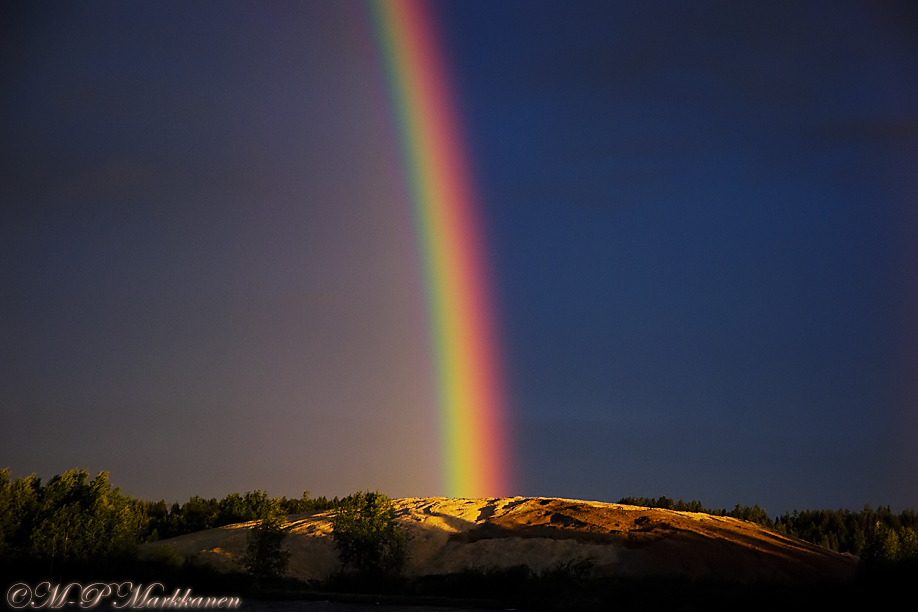
MIDNIGHT RAINBOW: It could only happen around
the summer solstice. "I recently witnessed a 'midnight rainbow,'"
reports M-P Markkanen of Kuusamo, Finland. "It towered high in the sky
and lasted from 10 pm until 3am local time on June 12th." He captured
the moment using a
Nikon D80: A rainbow at midnight. How can this be? Simple. Kuusamo is on the verge of the Arctic Circle, and at this time of year the sun never completely sets. Hanging low in the midnight sky, it shines up on distant rainclouds, creating a remarkably tall rainbow. "I guess you couldn't see a rainbow much taller than that," says Markkanen. "It was a clear sign of the coming solstice!" |
||||||||
| 6-20-10 sunspot 1082 - 1083 has vanished SUMMER SOLSTICE: Monday, June 21st, is the longest day of the year in the northern hemisphere. Northern summer begins at 11:28 UT (7:28 EDT) when the sun reaches its highest point on the celestial sphere; southern winter begins at precisely the same moment. No matter where you live, Happy Solstice!
FATHER'S DAY BLAST: Consider it a Father's Day gift ... from the sun. This morning around 1 a.m. UT, magnetic fields on the sun's eastern limb became unstable and erupted, producing one of the most spectacular explosions of the year. NASA's Solar Dynamics Observatory recorded the action:
The explosion did not cause a solar flare (a flash of electromagnetic
radiation) but it did hurl a massive cloud of magnetized plasma into
space:
SOHO movie. Because of the blast site's location on the eastern
limb, the cloud will not hit Earth. There won't be any geomagnetic
storms or auroras. Future eruptions, however, could have
greater effect. more sun-shots: from Alan Friedman of Buffalo, NY; from Les Marczi of Welland, Ontario, Canada; from Larry Alvarez of Flower Mound, Texas; from Michael Buxton of Ocean Beach, California; from Roger Williams of Kalamazoo, Michigan; from Robert Arnold of Isle of Skye, Scotland; from Cai-Uso Wohler of Bispingen, Germany; from Peter Desypris of Island of Syros Greece;
|
||||||||
| 6-19-10 sunspot 1082 and 1083 NASA's Solar Dynamics Observatory recorded the B4-category flare on June 17th. Each seemingly miniscule flash of light in the movie is a continent-sized blast dwarfing any explosion ever produced on Earth by many factors of ten. Believe it or not, solar physicists do consider this small. On the Richter scale of solar flares, B-flares are near the bottom, producing little or no effect on Earth. The really fearsome explosions are X-flares, more than a thousand times stronger than anything sunspot 1081 is likely to produce. X-flares will become more common as Solar Max approaches in 2013. Until then, relax. It's "only" a B-flare. Current conditions speed: 446.0 km/sec density: 1.4 protons/cm3 explanation | more data Updated: Today at 0315 UT 6-hr max: A7 1800 UT Jun18 24-hr: B1 1200 UT Jun18 explanation | more data Updated: Today at: 2355 UT Strange Martian Spirals Explained
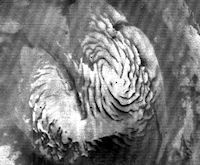
A 1972-era TV image of Mars' north polar cap. [more]
Jack Holt of the University of Texas and his graduate student Isaac Smith used radar data from MRO's Shallow Subsurface Radar to crack the case. Examining the details of this new data set has laid open the ice cap's internal structure, revealing clues to the massive ice troughs' formation. Apparently, the wind did it. "Radar cross sections reveal layers of ice deposited throughout the ice cap's history," says Holt. "The size and shape of those layers indicate that wind has played a key role in creating and shaping the spiral troughs." Not only does wind shape the spirals, but also it causes them to move. They rotate around the north pole, turning like an excruciatingly slow pinwheel, curiously enough, against the wind.Smith explains the process: "Cold air from the top of the ice cap sweeps down the slope, gaining speed and picking up water vapor and ice particles along the way. As this wind blows across the trough and starts up the other slope (the cooler side, facing away from the sun), it slows and precipitates the ice it holds. All of this ice is deposited on this cool slope, building it up, so the trough actually grows and migrates, over time, against the wind." 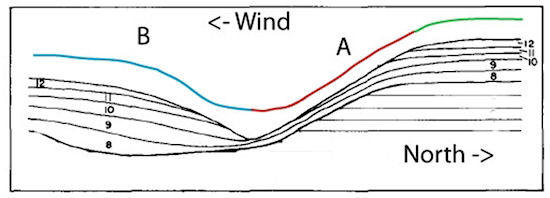
Alan Howard of the University of Virginia first suggested the
ice trough migration model based on Viking spacecraft data back
in 1982. His theory, that wind erosion and sunlight shape and
move the troughs, was never widely accepted, but the new data
supports it. [larger
image]
The Coriolis force generated by Mars' rotation twists the winds sweeping down from the ice cap. "That explains the troughs' spiral design," says Smith. Similar formations can be found in Antarctic regions of Earth, but without the spiral shape. 
Icy megadunes in Antarctica do not spiral like the ice troughs
of Mars. [more]
"You don't see spirals in Earth's Antarctic ice sheet because local topography there prevents the winds from being steered by the Coriolis force." The radar data have solved another icy mystery, too--the origin of Chasma Boreale. Chasma Boreale is a Grand Canyon-sized chasm that slashes through the midst of the spiraled troughs. Theories to date suggested that either wind erosion or a single melt event excavated Chasma Boreale within the past 5 to 10 million years. "Not so," says Holt. "The MRO data clearly show the chasm formed [long before the spirals did] in a much older ice sheet dating back billions of years. Due to the shape of that ancient sheet, the chasm grew deeper as newer ice deposits built up around it. Winds sweeping across the ice cap likely prevented new ice from building up inside the chasm [so it never filled up]." The radar data also revealed a second chasm matching Boreale in size. 
Chasma Boreale is indicated by an arrow in this modern image of
the Martian north pole. [more]
"This chasm's never been seen before -- unlike Boreale, it did fill up with ice, probably because it's in a different location. Boreale is closer to the highest points of the ancient ice cap, where the winds are stronger and more consistent." By discovering that both Chasma Boreale and the ice troughs were shaped by similar processes over different timescales, Holt and Smith answer some questions about Martian climate history. But they're also sparking new ones. "For a long stretch of Martian history the ice layers were regular and uniform, then there was a distinct period when the spiral ice troughs got started," says Smith. "Something changed. There must have been a very fast (relatively speaking) and powerful change in climate. We still don't know what that change was." "To figure that out, we need to look at the rest of Mars for evidence of other changes at that same time," says Holt. "This is just the tip of the ice berg."
|
||||||||
| 6-18-10 sunspot 1082 Current conditions speed: 482.9 km/sec density: 1.1 protons/cm3 explanation | more data Updated: Today at 2345 UT 6-hr max: A9 1755 UT Jun18 24-hr: B1 1200 UT Jun18 explanation | more data Updated: Today at: 2340 UT |
||||||||
| 6-17-10 Sunspot 1082 - just appearing NEW SUNSPOT: Magnetic fields are coalescing in the sun's northeastern quadrant to form a new sunspot. The growing active region is crackling with B-class flares, as shown in this movie from NASA's Solar Dynamics Obervatory.
HUBBLE FINDS NO DEBRIS: Even the Hubble Space Telescope cannot find any debris where an unknown object apparently hit Jupiter on June 3rd. Today, researchers released new HST images of the impact site, which show nothing but uninterrupted clouds. The non-detection is consistent with a relatively small asteroid or comet fragment making a shallow impact in Jupiter's high atmosphere. [more] Current conditions speed: 516.0 km/sec density: 1.4 protons/cm3 explanation | more data Updated: Today at 2346 UT 6-hr max: B1 1845 UT Jun17 24-hr: B4 1030 UT Jun17 explanation | more data Updated: Today at: 2340 UT |
||||||||
| 6-16-10 - no sunspots Current conditions speed: 508.3 km/sec density: 0.8 protons/cm3 explanation | more data Updated: Today at 2343 UT 6-hr max: A5 2125 UT Jun16 24-hr: A6 0525 UT Jun16 explanation | more data Updated: Today at: 2340 UT CALFORNIA ROCKET: Last night, sleepless sky watchers in California witnessed a bright light streak across the sky. It was not a meteor. "A unarmed Minuteman III rocket was launched from Vandenberg AFB at 3:01 PDT," reports Anthony Galvan III who took this picture from his backyard in Goleta, CA. "The missile's target was near the Kwajalein Atoll in the Marshall Islands, 4190 miles from the launch site." [more] |
||||||||
| 6-15-10 sunspot 1081 DEPARTING SUNSPOT: Sunspot 1081, the source of several picturesque solar flares over the weekend, is exiting stage right. The active region is rotating over the sun's western limb where it will soon be completely invisible from Earth. NASA's Solar Dynamics Observatory captured this parting shot: The active region's dramatic profile is highlighted by loops of unstable magnetism filled with surging, hot solar plasma. Black space beyond the edge of the sun provides a velvety backdrop for what could be some lively action in the hours ahead. Readers with solar telescopes, catch it before it goes! more images: from Robert Arnold of Isle of Skye, Scotland; from P-M Hedén of Vallentuna, Sweden; from Stephen Ames of Hodgenville, KY; from Gianfranco Meregalli of Milano Italy; Current conditions speed: 478.4 km/sec density: 4.2 protons/cm3 explanation | more data Updated: Today at 2335 UT 6-hr max: A6 1745 UT Jun15 24-hr: A7 1310 UT Jun15 explanation | more data Updated: Today at: 2340 UT AURORAS AT THE SOUTH POLE: On June 10th, a solar wind gust hit Earth's magnetic field, causing the skies over Antarctica to turn green. Research scientist J. Dana Hrubes snapped this picture of a backlit weather station at the Amundsen-Scott South Pole Station: The temperature reading? "-90 degrees F," says Hrubes. "It was cold," he allows, "but the skies were crystal clear and the auroras were very bright. It was a great time to be outside." June 16th or 17th could be another great time. That's when a solar wind stream is due to hit Earth, possibly sparking a new round of high-latitude geomagnetic storms. Stay tuned for more scenes from the South Pole. |
||||||||
| 6-14-10 sunspot 1081 SOLAR ACTIVITY: The circumference of the sun is crowded with prominences today, several of which have erupted in spectacular fashion: SOHO images. These massive events are wonderful targets for backyard solar telescopes. Pete Lawrence sends this example from his private observatory in Selsey UK: "June 14th is obviously prom day!" says Lawrence. "This impressive southeastern prominence looks like a wall of flame reaching out into space. If you have a solar telescope, try and get a look because it's still developing," he urges. more images: from Robert Arnold of Isle of Skye, Scotland; from P-M Hedén of Vallentuna, Sweden; from Stephen Ames of Hodgenville, KY; from Gianfranco Meregalli of Milano Italy; Current conditions speed: 371.5 km/sec density: 3.0 protons/cm3 explanation | more data Updated: Today at 2345 UT 6-hr max: A8 1745 UT Jun14 24-hr: C1 0050 UT Jun14 explanation | more data Updated: Today at: 2340 UT |
||||||||
| 6-13-`10 sunspot 1080 and 1081 SOLAR FLARE UPDATE:
Sunspot 1079 near the sun's southwestern limb has joined this weekend's
flare show (described below) with a series of its own M- and C-class
eruptions.
Click here for an SDO movie entitled "Blowing Bubbles." SOLAR FLARES: Sunspot 1081 is crackling with C- and M-class solar flares. Here is a picturesque C6-category blast recorded yesterday, June 12th (0917 UT), by NASA's Solar Dynamics Observatory (SDO):
An even stronger M2-class flare on June 12th (0055 UT) sparked a bright flash of extreme ultraviolet radiation, propelled a shock wave through the sun's atmosphere, and hurled a billion-ton coronal mass ejection (CME) into space. The CME is expected to miss Earth--so no auroras. The M-flare also produced a Type II radio burst. "Although the sun was setting here in New Mexico, I was able to record the burst at 28 MHz and 24 MHz," says amateur radio astronomer Thomas Ashcraft. "Here is an audio file. The slow swoosh you just heard is radio noise from the sun!" Another radio astronomer, Dick Flagg of Hawaii, used a radio spectrograph at Windward Community College in Oahu to record the burst's dynamic spectrum. Sunspot 1081 appears to be in a state of slight decay, but that has not stopped the flares. Indeed, the decay may be contributing to magnetic instabilities underlying these explosions. Readers with solar telescopes are encouraged to monitor developments. more images: from Cai-Uso Wohler of Bispingen, Germany; from David Evans of Coleshill, North Warwickshire, UK; from Alan Friedman of downtown Buffalo, NY; from Pavol.Rapavy of Observatory Rimavska Sobota, Slovakia; from Michael Borman of Evansville, Indiana; from Guenter Kleinschuster of Feldbach, Styria, Austria Current conditions speed: 400.4 km/sec density: 3.6 protons/cm3 explanation | more data Updated: Today at 2346 UT 6-hr max: B1 1810 UT Jun13 24-hr: C7 0540 UT Jun13 explanation | more data Updated: Today at: 2340 UT |
||||||||
| 6-12-10 sunspot 1080 and 1081 ACTIVE SUNSPOT: A new sunspot has popped up and it is crackling with solar flares. Today, AR1081 has unleashed a series of M- and C-class eruptions plus at least one strong shortwave radio burst detected by amateur radio astronomers on the Pacific side of Earth. High resolution movies of the flares and an audio recording of the solar radio burst may be found at http://spaceweather.com.
MYSTERY OF THE MISSING DEBRIS: On June 3rd, amateur
astronomers were startled by a bright flash of light on Jupiter. It
appeared to be an impact event--a comet or asteroid hitting the planet's
cloudtops. Curiously, though, the strike left no obvious debris. Was it
really an impact--or something else?
Today's story from Science@NASA discusses the possibilities. SOLAR FLARES: Today, June 12th at 0055 UT, new sunspot 1081 unleashed an impulsive M1-class solar flare. NASA's Solar Dynamics Observatory recorded the blast in high-resolution:
The explosion hurled a billion-ton coronal mass ejection (CME) off the sun's western limb; the cloud will probably not hit Earth. The explosion also produced a Type II radio burst. "Although the Sun was setting here in New Mexico, I was able to record the burst at 28 MHz and 24 MHz," says amateur radio astronomer Thomas Ashcraft. "Here is an audio file. The slow swoosh is radio noise from the sun!" The M2-flare was followed at 0917 UT by an even more picturesque C6-flare. SDO recorded that one, too: movie, still frame. More flares seem likely as restless sunspot 1081 continues to grow. Readers with solar telescopes are encouraged to monitor developments. Current conditions speed: 343.4 km/sec density: 2.2 protons/cm3 explanation | more data Updated: Today at 1902 UT 6-hr max: B2 1425 UT Jun12 24-hr: M1 0055 UT Jun12 explanation | more data Updated: Today at: 2020 UT |
||||||||
| 6-11-10 - sunspot 1078 and 1080 Current conditions speed: 387.4 km/sec density: 2.8 protons/cm3 explanation | more data Updated: Today at 1745 UT 6-hr max: B1 1200 UT Jun11 24-hr: B1 1200 UT Jun11 explanation | more data Updated: Today at: 1740 UT MAGNETIC UNREST: The magnetic field of sunspot 1078 is in a state of considerable unrest. Explosive reconnection events are happening every few minutes, resulting in a staccato rat-a-tat of low-level solar flares. The following movie from NASA's Solar Dynamics Observatory gives a one-hour sampling of the action:
Eventually, this growing sunspot could unleash a truly significant flare. Our planet, however, is not in the line of fire. Sunspot 1078 is turning away from Earth and will soon disappear over the sun's western limb. Readers with solar telescopes are encouraged to catch it before it goes. more images: from John C McConnell of Maghaberry Northern Ireland; from Peter Paice of Belfast, Northern Ireland; from Pavol Rapavy of Observatory Rimavska Sobota, Slovakia 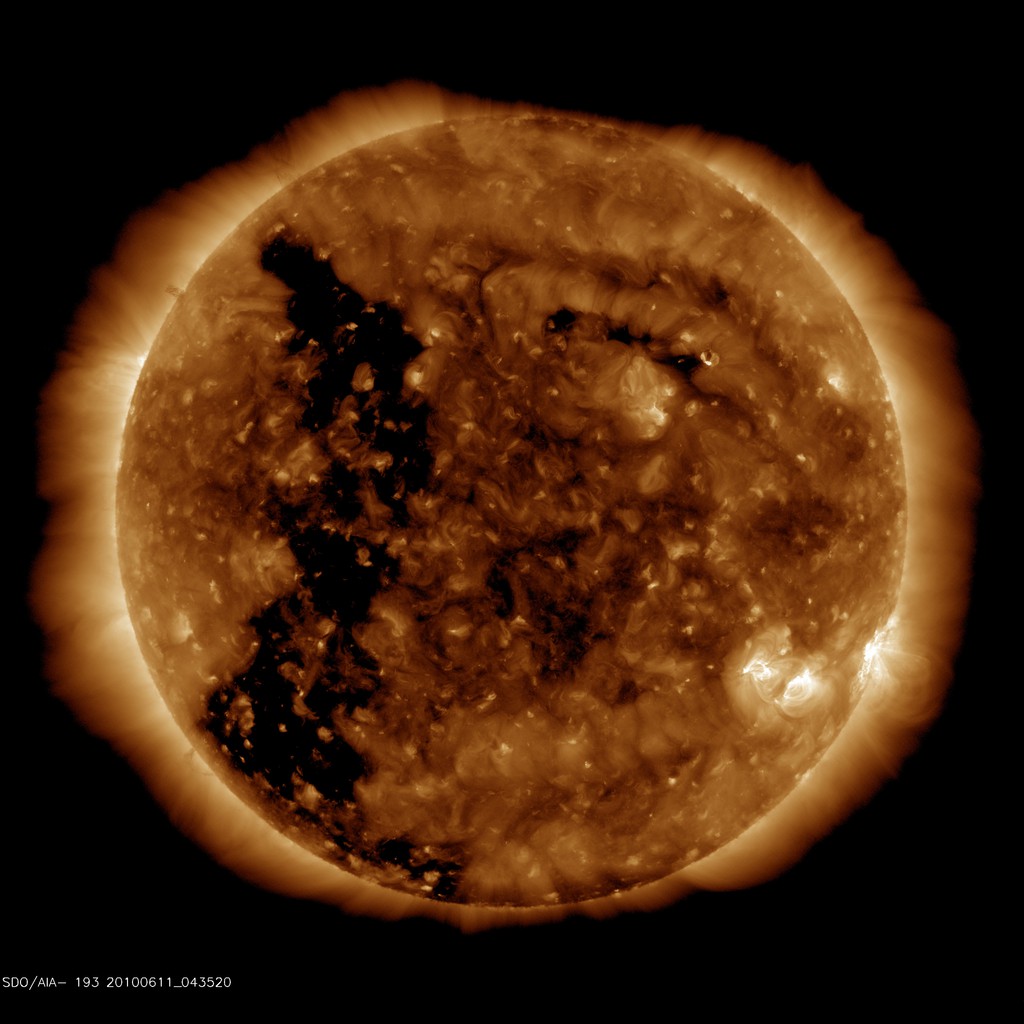 This coronal hole is not the same one as the one above. This is another one. It is equally large and equally dangerous to earth. On the 15th of month - picture this same image - just more to the right.
WATCH OUT FOR THAT COMET: One wonders... Did the inhabitants of galaxy NGC 891 duck when Comet McNaught flew past the edge-on spiral on the morning of June 8th? Mike O'Connor and Tristan Dilapo took this picture of the cosmic close encounter from Colden, New York: "The comet was only 10 degrees above the horizon," says O'Connor.
"Nevertheless, we got a good picture using a 12-inch telescope and an
SBIG ST9-E camera." And, no, the denizens of that distant galaxy did not flinch, flee, duck or take notice in any way. NGC 891 is 30 million light years away, far removed from the willowy tail of Comet McNaught. We Earthlings are having the true close encounter. Comet McNaught (C/2009 R1) is gliding through the inner solar system, due to approach our planet only 100 million miles away on June 15th and 16th. The approaching comet looks great in small telescopes, and may yet become a naked-eye object before the end of the month. Because this is Comet McNaught's first visit, predictions of future brightness are necessarily uncertain; amateur astronomers should be alert for the unexpected.
more images: from Kerry-Ann Lecky Hepburn of Grimsby, Ontario; from Gregg Ruppel of Ellisville, MO; from Michael Jäger of Turmkogel, Austria; from Scott Tucker of Tucson, Arizona; from Jeff Greenwald of Laramie, Wyoming; from Feys Filip at the Public observatory "Sasteria" in Crete; from Gary of Fort Davis, TX; from Baqir of Quetta, Pakistan
new comet cometh
Will the celestial omen of the fall of tyrants strike again?
|
||||||||
| 6-10-10 sunspot 1078 and 1079 Current conditions speed: 432.0 km/sec density: 2.1 protons/cm3 explanation | more data Updated: Today at 2344 UT 6-hr max: A9 2000 UT Jun10 24-hr: A9 2000 UT Jun10 explanation | more data Updated: Today at: 2340 UT FANTASTIC PROMINENCE: A long filament of magnetism circling the sun's north pole is rising into space, producing a truly fantastic prominence. NASA's Solar Dynamics Observatory took this picture just hours ago: The extreme ultraviolet image shows a cloud of hot
(60,000 K) plasma held suspended above the stellar surface by
filamentary magnetic forces. The structure is five times taller than
Earth and at least 20 times as long. These dimensions make it a fine
target for backyard
solar telescopes as well as advanced spacecraft. If the filament becomes unstable and collapses (as
magnetic filaments often do), plasma hitting the stellar surface could
explode, resulting in a type of flare called a "Hyder flare." To whet
your appetite for action, browse the filament in
stunning 4096x4096 resolution. more images: from Pete Lawrence of Selsey, West Sussex, UK; from Robert Arnold of Isle of Skye, Scotland; from Pavol Rapavy of Observatory Rimavska Sobota, Slovakia ASTEROID SAMPLE RETURN: Nearing the end of a seven year, two billion km odyssey, Japan's Hayabusa spacecraft is set to return to Earth this Sunday (7 am PDT) carrying a piece of near-Earth asteroid Itokawa. The sample return capsule will blaze through the atmosphere over Australia and land via parachute in the remote Woomera Test Range. The Hayabasa mothership will follow the capsule into Earth's atmosphere, but never make it to the ground, instead disintegrating in a spectacular fireball. |
||||||||
| 6-9-10 - no sunspots today Current conditions
speed: 407.1 km/sec density: 1.1 protons/cm3 explanation | more data Updated: Today at 2356 UT
6-hr max: B1 2150 UT Jun08 24-hr: B1 1350 UT Jun08 explanation | more data Updated: Today at: 2350 UT
COMET McNAUGHT: A fresh comet is swinging through the inner solar system, and it is brightening rapidly as it approaches the sun. Presenting, Comet McNaught (C/2009 R1):
Michael Jäger of Stixendorf, Austria, took the picture on June 6th using an 8-inch telescope. The comet's green atmosphere is larger than the planet Jupiter, while the long willowy ion tail stretches more than a million kilometers through space. These dimensions make the comet a fine target for backyard telescopes. Comet McNaught can be found low in the northeastern sky before dawn gliding through the constellation Perseus. It is brightening as it approaches Earth for a 1.13 AU close encounter on June 15th and 16th. Currently, the comet is at the threshold of naked eye visibility (5th to 6th magnitude) and could become as bright as the stars of the Big Dipper (2nd magnitude) before the end of the month. Because this is the comet's first visit to the inner solar system, predictions of future brightness are necessarily uncertain; amateur astronomers should be alert for the unexpected. [ephemeris] [3D orbit] [Sky & Telescope: sky map, full story] more images:
from John Chumack of Yellow Springs, Ohio;
from Primoz Cigler of Bohor, Slovenia;
from Pete Lawrence of Selsey, West Sussex, UK;
from Feys Filip at the Public Observatory "Sasteria" in Crete;
from Monika Landy-Gyebnar of Veszprem, Hungary;
from Petr Horalek of Ustupky, Czech republic;
|
||||||||
| 6-8-10 no sunspot today NEW COMET McNAUGHT: A fresh comet is swinging through the inner solar system, and it is brightening rapidly as it approaches Earth for a 100 million mile close encounter in mid-June. Comet McNaught (C/2009 R1) has a vivid green head and a long wispy tail that look great through small telescopes. By the end of the month it could be visible to the naked eye perhaps as bright as the stars of the Big Dipper. Because this is the comet's first visit to the inner solar system, predictions of future brightness are necessarily uncertain; amateur astronomers should be alert for the unexpected. Visit http://spaceweather.com for sky maps, photos and more information. Current conditions speed: 407.3 km/sec density: 0.5 protons/cm3 explanation | more data Updated: Today at 2344 UT 6-hr max: B1 2150 UT Jun08 24-hr: B1 1350 UT Jun08 explanation | more data Updated: Today at: 2340 UT |
||||||||
| 6-7-10 - last day of sunspot 1076
FAREWELL SUNSPOT 1076:
To the Hubble-sharp eyes
of NASA's Solar Dynamics Observatory, even absent sunspots appear
fantastic. Hours ago, SDO photographed the magnetic canopy of departing
sunspot 1076 rising over the sun's southwestern limb:
The loops in this extreme ultraviolet image (171 Å) are intense magnetic fields filled with glowing-hot plasma. No longer visible (because it has rotated over the horizon) is the sunspot's complex of dark cores where the magnetic field is strongest of all. No matter, the canopy is impressive enough. Click here to browse the full-disk image in 4096x4096 resolution. |
||||||||
| 6-6-10 - sunspot 1076 - its almost off the edgebr />
Current conditions speed: 416.1 km/sec density: 0.4 protons/cm3 explanation | more data Updated: Today at 1626 UT
6-hr max: A5 1425 UT Jun06 24-hr: B1 0255 UT Jun06 explanation | more data Updated: Today at: 1620 UT
As the Sun Awakens, NASA Keeps a Wary Eye on Space WeatherJune 4, 2010: Earth and space are about to come into contact in a way that's new to human history. To make preparations, authorities in Washington DC are holding a meeting: The Space Weather Enterprise Forum at the National Press Club on June 8th. Richard Fisher, head of NASA's Heliophysics Division, explains what it's all about: "The sun is waking up from a deep slumber, and in the next few years we expect to see much higher levels of solar activity. At the same time, our technological society has developed an unprecedented sensitivity to solar storms. The intersection of these two issues is what we're getting together to discuss." The National Academy of Sciences framed the problem two years ago in a landmark report entitled "Severe Space Weather Events—Societal and Economic Impacts." It noted how people of the 21st-century rely on high-tech systems for the basics of daily life. Smart power grids, GPS navigation, air travel, financial services and emergency radio communications can all be knocked out by intense solar activity. A century-class solar storm, the Academy warned, could cause twenty times more economic damage than Hurricane Katrina. Much of the damage can be mitigated if managers know a storm is coming. Putting satellites in 'safe mode' and disconnecting transformers can protect these assets from damaging electrical surges. Preventative action, however, requires accurate forecasting—a job that has been assigned to NOAA. "Space weather forecasting is still in its infancy, but we're making rapid progress," says Thomas Bogdan, director of NOAA's Space Weather Prediction Center in Boulder, Colorado. Bogdan sees the collaboration between NASA and NOAA as key. "NASA's fleet of heliophysics research spacecraft provides us with up-to-the-minute information about what's happening on the sun. They are an important complement to our own GOES and POES satellites, which focus more on the near-Earth environment." Among dozens of NASA spacecraft, he notes three of special significance: STEREO, SDO and ACE. STEREO (Solar Terrestrial Relations Observatory) is a pair of spacecraft stationed on opposite sides of the sun with a combined view of 90% of the stellar surface. In the past, active sunspots could hide out on the sun's farside, invisible from Earth, and then suddenly emerge over the limb spitting flares and CMEs. STEREO makes such surprise attacks impossible. SDO (the Solar Dynamics Observatory) is the newest addition to NASA's fleet. Just launched in February, it is able to photograph solar active regions with unprecedented spectral, temporal and spatial resolution. Researchers can now study eruptions in exquisite detail, raising hopes that they will learn how flares work and how to predict them. SDO also monitors the sun's extreme UV output, which controls the response of Earth's atmosphere to solar variability. Bogdan's favorite NASA satellite, however, is an old one: the Advanced Composition Explorer (ACE) launched in 1997. "Where would we be without it?" he wonders. ACE is a solar wind monitor. It sits upstream between the sun and Earth, detecting solar wind gusts, billion-ton CMEs, and radiation storms as much as 30 minutes before they hit our planet. "ACE is our best early warning system," says Bogdan. "It allows us to notify utility and satellite operators when a storm is about to hit.” NASA spacecraft were not originally intended for operational forecasting—"but it turns out that our data have practical economic and civil uses," notes Fisher. "This is a good example of space science supporting modern society." 2010 marks the 4th year in a row that policymakers, researchers, legislators and reporters have gathered in Washington DC to share ideas about space weather. This year, forum organizers plan to sharpen the focus on critical infrastructure protection. The ultimate goal is to improve the nation’s ability to prepare, mitigate, and respond to potentially devastating space weather events. "I believe we're on the threshold of a new era in which space weather can be as influential in our daily lives as ordinary terrestrial weather." Fisher concludes. "We take this very seriously indeed." For more information about the meeting, please visit the Space Weather Enterprise Forum home page at http://www.nswp.gov/swef/swef_2010.html.
BLUE STAR MEETS RED PLANET: "Tonight, look to the west after the sky has gone dark and there you'll find a spectacular new 'double-star,'" says Pete Lawrence of Selsey UK. "It is Mars in conjuncton with the bright blue star Regulus." He took this picture on June 5th: "Both are about the same brightness, but the color contrast is absolutely wonderful," he continues. "An exquisite sight with the naked eye, binoculars or low power in a telescope - catch it while it lasts!" [sky map] more images: from Jens Hackmann of Weikersheim, southern Germany; |
||||||||
| 6-5-10 - sunspot 1076 CORONAL HOLE: NASA's Solar Dynamics Observatory is monitoring a dark rift in the sun's atmosphere. The spacecraft's Atmospheric Imaging Assembly (AIA) took this extreme ultraviolet picture just hours ago: It's a "coronal hole," a vast region where the sun's magnetic field
has opened up and allowed the solar wind to escape. Indeed, a solar wind
stream flowing from this hole is heading toward Earth, due to arrive on
June 7th or 8th. High latitude sky watchers should be
alert for auroras on those
dates. Hi-res Bonus: A 4096x4096 pixel version of this image is available. Click here to explore the coronal hole in high resolution. Hi-res Bonus #2: "I was examining the dark rift on the sun, when I noticed a peculiar and familiar image," says Micheal French of Washington DC. "At 1988x2645 on the high-res image, there is a design that looks like a human eye: image. I scoff at such things, the face on Mars, etc, but you must admit they are pretty neat. I think our brains are designed to find familiar things, and mine did just that." Current conditions
speed: 468.0 km/sec density: 1.8 protons/cm3 explanation | more data Updated: Today at 2344 UT
6-hr max: A6 1945 UT Jun05 24-hr: A9 0920 UT Jun05 explanation | more data Updated: Today at: 2340 UT JUPITER IMPACT! Amateur astronomers Anthony Wesley of Australia and Christopher Go of the Philippines have independently observed an impact event on Jupiter. The strike occurred at 20:31 UT on June 3rd and produced a bright flash of light in the giant planet's cloudtops:
"I still can't believe that I caught a live impact on Jupiter," says Go, who has made a must-see video of the event."There were no visible remains at the impact point for the next half hour or so, until sunrise put an end to the imaging," says Wesley. The nature of the impactor is presently unknown. It might have been an asteroid or a comet. In either case, a dark and cindery debris field is expected to develop around the impact point; that's what has happened in the aftermath of previous Jupiter impacts. Astronomers are encouraged to monitor Jupiter, and stay tuned for updates. Update #4 (June 5, 1200 UT): "This morning I woke up at 6 am local time (9 UT) to see Jupiter with my 120 mm refractor," reports Mariano Ribas of Buenos Aires, Argentina. "The planet was high in the sky (45-50° over horizon). I observed carefully for almost two hours with my telescope, using 110 to 200 x, but I saw nothing at all in the impact zone, which transited at 10:51 UT." Update #3 (June 4, 2200 UT): A full day has elapsed since the flash, and many observatories have imaged the impact site. So far, a prominent debris cloud has not emerged. Was this impactor too small to produce much debris? Observations will continue... Update #2 (June 4 1500 UT): Wesley has posted a 46 MB video of the impact on his web page. A smaller version is available here. Update #1 (June 4, 0100 UT): Anthony Wesley has pinpointed the impact site at Jovian latitude minus 16.1o, and central meridian longitudes CM1: 300o, CM2: 33.8o and CM3: 210.4o. |
||||||||
| 6-4-10 - sunspot 1076 Current conditions speed: 531.6 km/sec density: 0.5 protons/cm3 explanation | more data Updated: Today at 2345 UT
6-hr max: A6 2015 UT Jun04 24-hr: A9 0310 UT Jun04 explanation | more data Updated: Today at: 2340 UT |
||||||||
6-3-10 - sunspot 1076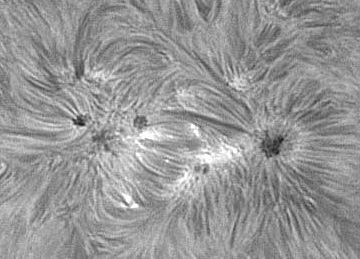 Current conditions speed: 566.9 km/sec density: 0.9 protons/cm3 explanation | more data Updated: Today at 2345 UT
6-hr max: A8 2050 UT Jun03 24-hr: B1 1355 UT Jun03 explanation | more data Updated: Today at: 2340 UT |
||||||||
| 6-2-10 - Sunspot 1076 Current conditions speed: 440.9 km/sec density: 0.2 protons/cm3 explanation | more data Updated: Today at 2345 UT 6-hr max: B1 2255 UT Jun02 24-hr: B1 2255 UT Jun02 explanation | more data Updated: Today at: 2340 UT ASTROPHOTO-OP: Dwarf planet Ceres (formerly giant asteroid Ceres) is passing by the Lagoon Nebula in Sagittarius tonight. Both the nebula and the dwarf planet are easy targets for small backyard telescopes. Astrophotographers, point your optics here. Images: from Rob Kaufman of Bright, Victoria, Australia. 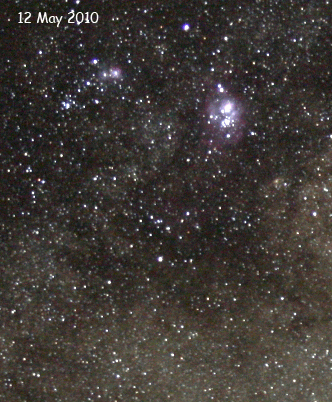
Jupiter's crash of '09
Asteroid is most likely suspect in last summer's planetary
impact
Web edition :
Wednesday, June
2nd, 2010
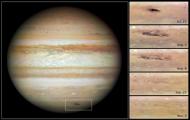
BRUISEDJupiter
shows an elongated dark spot (in box, bottom right of main
image) in this image taken by the Hubble Space Telescope on
July 23, 2009. The blemish was created when an unknown
object, now thought to have been an asteroid, plunged into
Jupiter, scattering debris into the planet's cloud tops.
Close-up images (right) show the impact site rapidly
disappearing as winds dispersed the debris over the next few
months.M.H. Wong/UC
Berkeley, H.B. Hammel/Space Science Institute, I. de
Pater/UC Berkeley, and the Jupiter Impact Team, NASA, ESA
The body that slammed into Jupiter last July almost certainly was an asteroid rather than a comet, and such impacts might happen as often as every 10 to 15 years, new calculations and an analysis of observations taken last summer suggest.
If researchers are correct in their analysis, images taken by the Hubble Space Telescope and other instruments may have captured for the first time the immediate aftermath of an asteroid striking a planet. The circumstantial evidence in favor of an asteroid comes in part from comparing Hubble Space Telescope images of the 2009 impact site with Hubble images of Jupiter recorded in 1994, when another impactor, the comet Shoemaker-Levy 9, struck the planet.
Before that impact, each fragment of Shoemaker Levy-9, which had broken apart during an earlier passage by Jupiter, was surrounded by a cloud of dusty debris, called a coma, that clearly identified the fragments’ source as a comet. The impact of the tiny particles that made up each coma generated the extended dark halo seen in Hubble’s 1994 ultraviolet images, notes Heidi Hammel of the Space Science Institute in Boulder, Colo. In contrast, she notes, the single body that smacked into Jupiter in 2009 produced no such halo, which argues for an asteroid as the source.
Hammel and her colleagues, including Agustín Sánchez-Lavega of Universidad del País Vasco in Bilbao, Spain, describe their findings in the June 1 Astrophysical Journal Letters.
In a separate article in the same issue, Sánchez-Lavega, Hammel and collaborators suggest that an object about 500 meters across strikes Jupiter every 10 to 15 years. Previous estimates, based solely on the 1994 collision, had put the rate at about once a century.
Although the new estimate is still based on limited data — from the bodies that collided with Jupiter in 1994 and 2009 — the researchers considered in their analysis the frequency of other observations from space and from the ground, as well as the data’s quality.
Amateur astronomers, with their continual monitoring of Jupiter, will be a great help in understanding the actual impact rate, Hammel says.
The researchers conclude there’s a 50-50 chance the 2009 impactor was an asteroid, but that estimate is based only on tracing the body’s orbit back in time. “We cannot be more precise due to uncertainty in the impact time,” says Sánchez-Lavega. Astronomers didn’t see the actual impact, which occurred on July 19, but only its aftermath.
It’s the Hubble observations, along with images and spectra from other telescopes, that tip the balance in favor of an asteroid, comments Carey Lisse of the Johns Hopkins Applied Physics Laboratory in Laurel, Md.
According to the calculations of the impactor’s path, if the culprit was indeed an asteroid, it most likely came from the Hilda family of asteroids in the outer part of the main asteroid belt, which lies between the orbits of Mars and Jupiter.
Taken together, the two new studies indicate that the population of potential impactors in Jupiter’s neighborhood is much greater than previously thought and that many of these bodies are rocky, like asteroids, rather than icy, like comets, says Andy Cheng of the Applied Physics Laboratory.
Jupiter’s gravity wields enormous influence, sweeping objects out of its neighborhood and also trapping some of them, such as the Hilda asteroids, in particular regions of space, he notes.
|
||||||||
| 6-1-10 - sunspot 1076 SUNSPOTS: MEMORIAL DAY FIREWORKS: On May 31st, around 2100 UT, a magnetic filament erupted on the sun. NASA's Solar Dynamics Observatory (SDO) recorded the action with 10-times HDTV resolution. Click on the image to play the movie--and be alert for "the twist!"
Magnetic filaments on the sun are a bit like rubber bands. They store energy when they are twisted. Take a rubber band from your desk and try it--twist, twist, twist. Eventually it will reach its fill and untwist explosively. That's more or less what happened on the sun. Play the movie again and note the untwisting motions near the center of the tempest. SDO's clear vision is revealing how these explosions work in unprecedented detail. Stay tuned for more. Current conditions speed: 518.6 km/sec density: 0.4 protons/cm3 explanation | more data Updated: Today at 2345 UT 6-hr max: A6 1915 UT Jun01 24-hr: A6 1915 UT Jun01 explanation | more data Updated: Today at: 2340 UT |
SPACE DATABASE ON THIS SITE/a>
DREAMS OF THE GREAT EARTHCHANGES -
MAIN INDEX